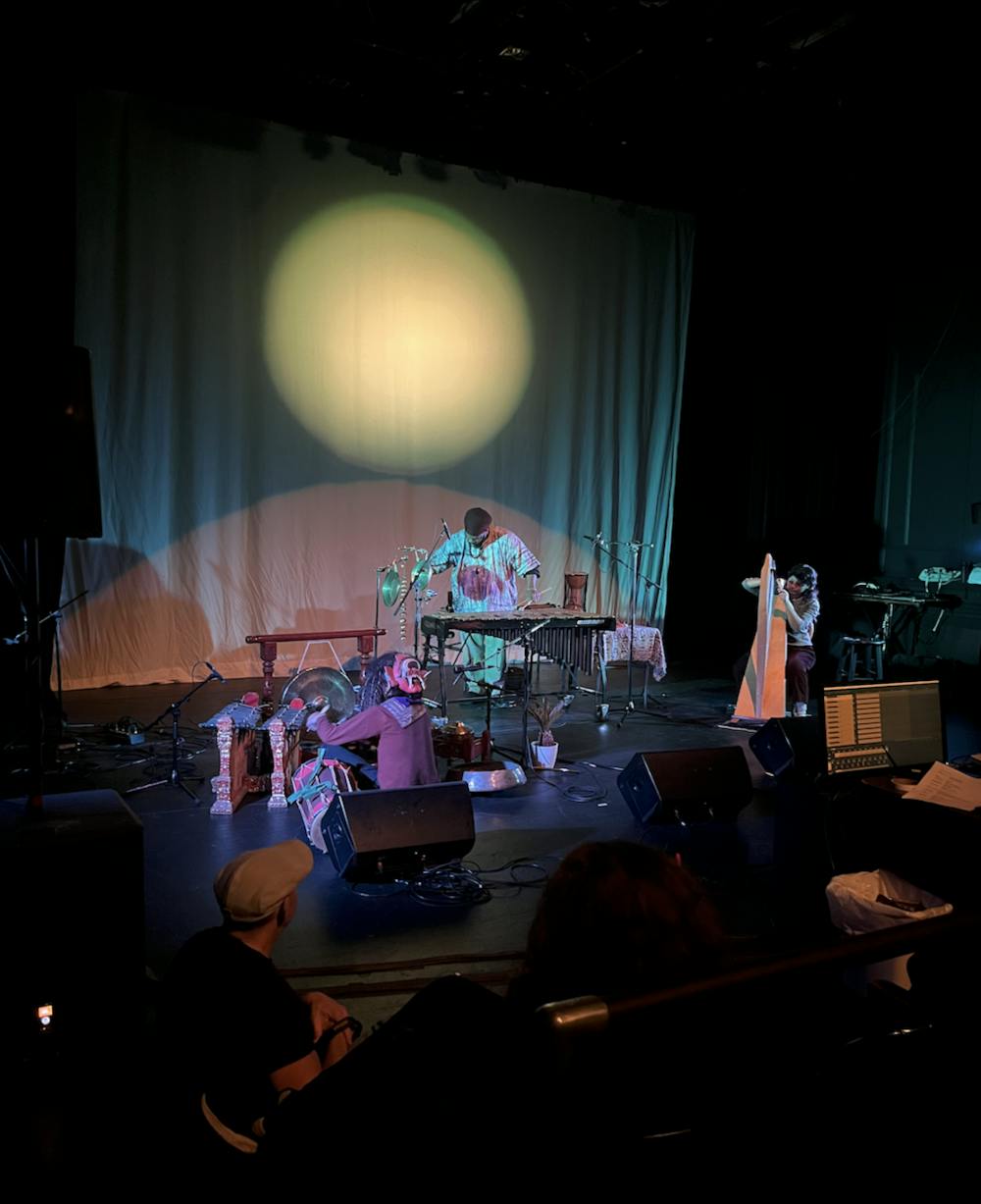From Sept. 19 to 22, the Baltimore Theatre Project, in collaboration with the High Zero Foundation, hosted this year’s annual High Zero festival. Over four days, 20 improvised sets featuring four solo acts and 16 group performances showcased the best of Baltimore’s experimental music scene.
As I walked up the stairs to the upper level of the theater, I listened to echoes of raspy wails grow louder and louder, a good sign I was in the right place. I opened the door and looked down at the scene below. Alone on the stage was a flautist in a gray jumpsuit under two white spotlights. I scrambled to claim the only empty seat in the completely packed theater and pleasantly watched as attendees who entered later found space on the steps below. Meanwhile, the flautist, Rachel Beetz, took in big gulps of air through the pipe and then exhaled, eventually churning her labored breathing into a sort of mechanized beat. I felt I was watching someone toggle over the video playback, swiping backward and forward to achieve her electro-esque, robotic sounds.
In an interview with The News-Letter, Beetz explained the unique process behind these compositions.
“Well, I had to decide what tools to bring with me, the kind of material and how to develop it... but, as for the specifics, [those were] really open. I just had my setup and did whatever felt right in the moment,” she said.
As if she had made it too easy for the audience to make out a comprehensive rhythm, Beetz then pressed down on a feedback foot pedal, instantly stretching out the flute’s raspy wheezes into a beautiful composition of frantic hospital machinery. You could almost make out the beep of a heart monitor, which became even more ominous as its cadence slowed to its eventual halt.
Commenting on experimental music at High Zero Festival, Beetz said: “It feels really good to be part of this open-ended kind of music and also for the community to be supportive of each other... It's really a beautiful thing.”
Beetz stepped off with her chair, and the stage crew replaced her tech board with a whole ensemble of music making items. These included the familiar ones — a microphone, saxophone, and keyboard — alongside some not familiar ones — like balloons and a box of metal trinkets. It did not take long to know how they were all going to be incorporated into the set.

Performers play various instruments on stage, from left to right: Patrick McMinn, Darien Baiza, Ishmael Ali, The Emperor King Bishop Soloman Selassie
Saxophonist Sam Newsome breathed out slow moans, heavy enough to make you feel like you were in a velvet-curtained, smoke-filled, jazz cafe. It was accompanied by the whispers of trumpeter Chris Williams and hums of vocalist Bonnie Lander, singing regal “ooh’s” and “ah’s.” Their volume increased slowly but surely, with the vocalist making jittery wails and the saxophone replaced by the sounds of rummaging through the metal toy box. All of the sudden, a blue light flashed across the side of the faces of the performers – making me think that the coincidental strumming of a newly appeared triangular banjo – played by Che Davis, had opened up a celestial portal just out of sight behind the stage.
Beetz explained that most of the musicians would not even meet before playing together, saying they simply “set up their stuff, do a sound check and go.”
“You can see it on stage: They’re really listening to each other, making their sounds, but listening and pausing or changing depending on what they hear,” she added.
The next act, too, was armed with an eclectic mix of instruments: a gong, a harp, three xylophones and a cup inside a metal bin. A yellow light focused above them while a figure on the ground, dressed with a red mask strapped to the back of their head, made the initial swing of the gong. Jamal Moore moved meticulously between pleasing harmonies and dissonant clashes of notes on the xylophone while the gong-player sputtered and hiccuped into a microphone.
In an interview with The News-Letter, artist Putu Tangkas Adi Hiranmayena explained how his cultural background and heritage influenced his music.
“My family came from Indonesia to the U.S. to teach gamelan... I learned [gamelan] by being in the room with my parents, just, like, napping! Which actually isn't far off from what happens in Bali where the kids are around and they fall asleep in their parents laps, listening, he said. “That’s how I got my footing in gamelan, but I’m kind of doing erratic and more experimental stuff.”
Hiranmayena soon substituted his vocals for a clanking sound he produced by shaking the bin with the cup inside and providing some low notes on the xylophone to pair with Moore’s more cheery, higher-pitched chords. In this set's crescendo, Moore quickly brought his own metal trinkets and began picking them up just to throw them back on their table at will.
A bongo appeared to be beat in a scattered rhythm, and the harp underwent a seizure of repeated pluckings of high-pitched strings. Their ensemble held tempo for a few moments, giving the audience the opportunity to focus in on any one part of their collective chaos, until they descended into infrequent beeps and taps. At the very end, in near silence, Hiranmayena, having only ever shown the audience his mask covering the back of his head, exclaimed, “You stole our land! You keep taking it! Practice your sex yoga on my grandmother's bed!”
He said that he did not expect for the audience to fully understand the story but, rather, “be kind of curious, asking ‘why did I see that?’ Or even to look introspectively and ask themselves ‘am I one of those people?’”
Hiranmayena went on, describing his background and how it motivates his work:
“Bali has been a sort of a tourist playground for many years, and it was promoted as this island of spiritual utopia. What started happening was a lot of expats and people coming in, overstaying visas, and create these new age practices that were imposing on the Balinese people there... When I say grandmother, I am thinking about the familial grandmother but also her as an environmental and agricultural symbol where space is being disrespected,” Hiranmayena continued.
The next performance began with one of the artists, Sam Pluta, giving a classic introduction: “Ladies and gentleman, boys and —.” Before concluding, he repeated his line again and again, mixing around all the words and shaking his head from one side to the other while perfectly maintaining his 1960s showman accent. Only a minute or so was enough for the two mixers (Obie Feldi, CK Barlow) to catch a sample and begin their impressive tirade of sound.
At one point, I felt I was inside a washing machine as it wrings clothes at the end of its cycle. At another, I could close my eyes and imagine myself walking on a cloud of glittering ice crystals. These moments were laced together by Mary Staubitz who, according to the pamphlet, plays “objects.” Most exemplary of all was the swishing of a metal rake dragging the same can used by Hiranmayena.
In an interview with The News-Letter, Martin Schmidt, president of the High Zero Foundation, chuckled and explained that Staubitz was “his pick” for a performer.
“Our rule is to pick out things that are sort of unusual... to not [play] idiomatic music like a rock band. Or ‘oh, but it's hip hop.’ We don't want that. We want to do things that are hard to put a name on,” he said.
When asked about the impact of High Zero as one of the focal points of experimental music in Baltimore, he responded: “High Zero is so strange but never going away... it’s this thing. The posters go up, and some people say they hate it or they think it's dumb. But they know about it, and it’s [an] institution that has an effect. It is my theory that it has affected [conventional musicians] and made them a little stranger than they otherwise would be.”
A long intermission separated this act from the final one. Instruments were swapped and rearranged, and the performers were given a long welcoming applause as they walked on. While some of the performers wore only a t-shirt and jeans – The Emperor King Bishop – Solomon Selassie entered with a gold-threaded, cream-colored robe and matching hat, well suited for his stage name.
During the performance, he sang in an angelic soprano, while the very skilled cellist Ishmael Ali raced up and down the neck of his instrument. Patrick McMinn blared single notes that fell into solemn wheezes, and Darien Baiza played soft rhythms on the drums. Towards the end, crunchy reverb from Selassie’s mixing board dominated the soundscape, and Ali stopped his plucking to saw at his strings with a bow, washing the theater with hollow squeaks. These sounds became more and more infrequent until their eventual deaths, though the audience had to wait to make sure the band had truly finished. Once enough silence had passed, we gave a long standing ovation, marking the end of this year’s High Zero.
“We have been around for 26 years, but this is the first time that we have sold out every single night,” said Schmidt.
This being his first time at High Zero, Hiranmayena gave his thoughts at the end of this year’s event.
“I love High Zero because it’s such a good festival for not only meeting with people, but also for being here for four days and having an indeterminate way of putting groups together,” he said. “They’re such beautiful humans and really good listeners; they are all extremely unapologetic. It’s something I really appreciate.”





